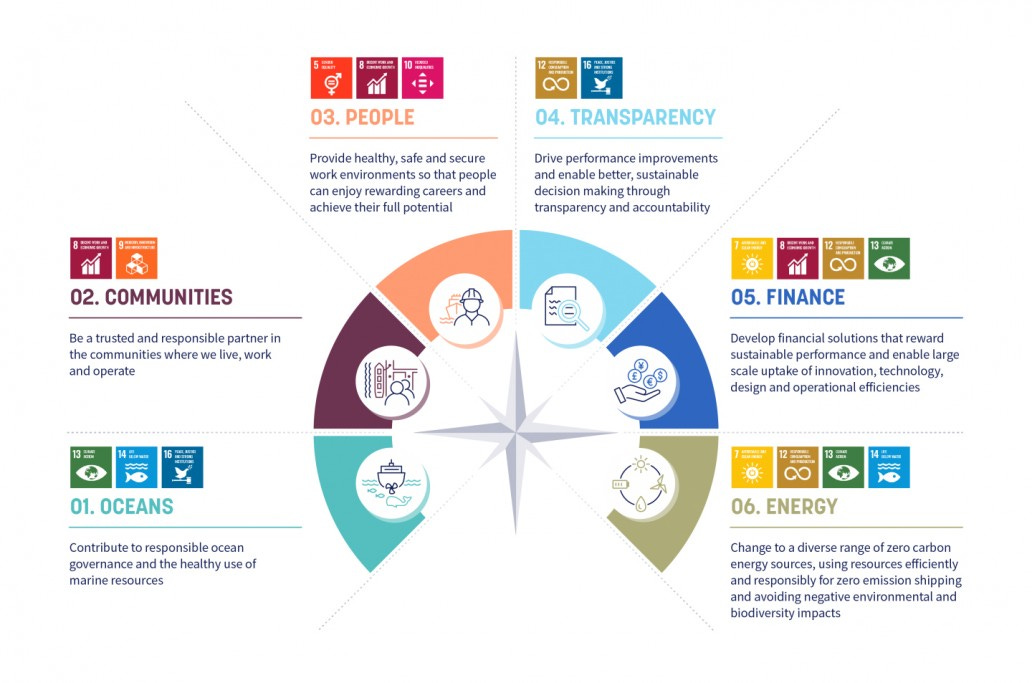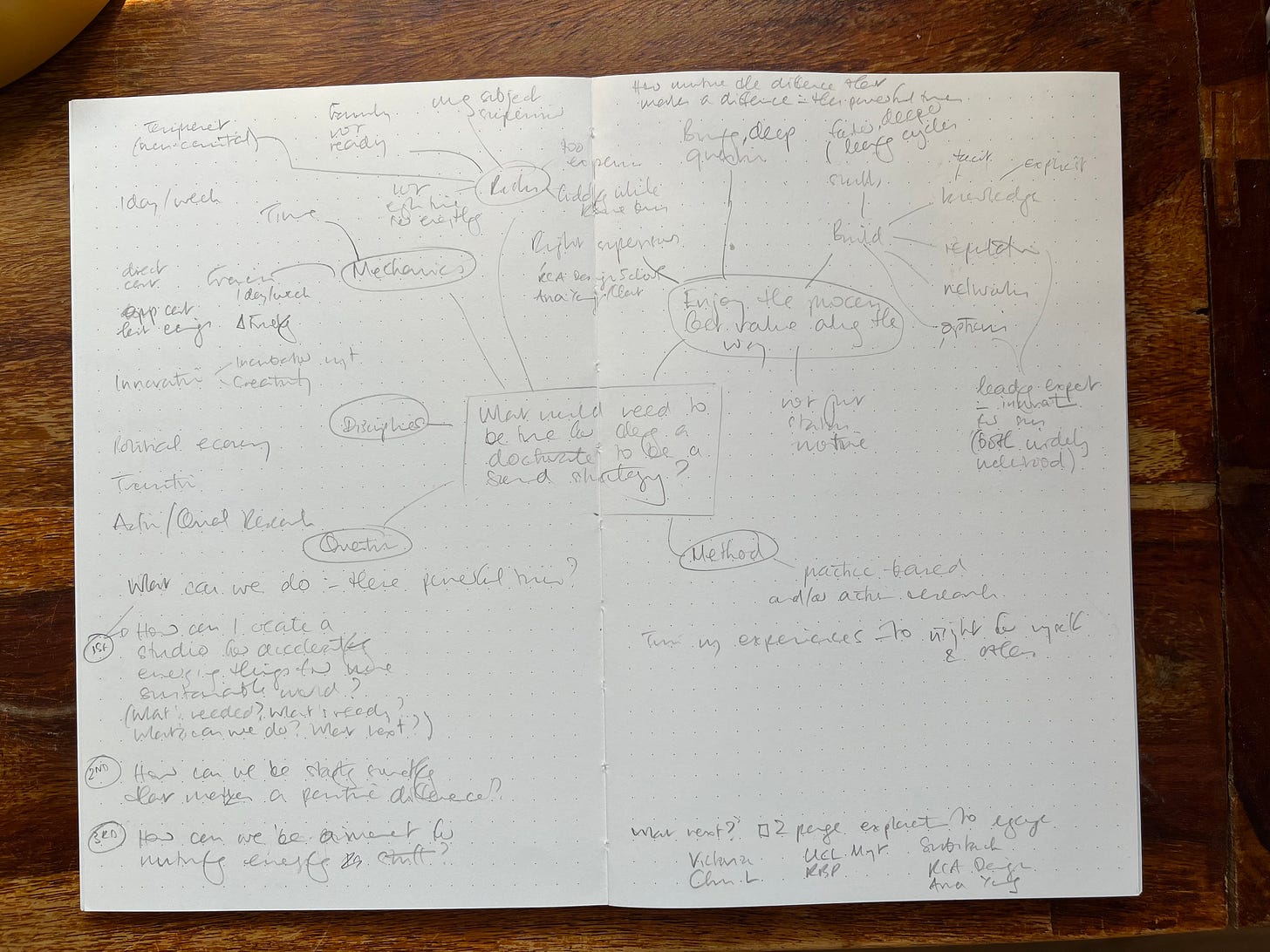I am writing newsletter of #weeknotes about starting the Atelier of What’s Next (What’s needed, What’s ready? What can we do? What next?) on Substack (this one here on Fri 9 June 2023). I’m publishing here under Cory Doctorow’s “write once, syndicate everywhere”. To get regular updates on the Atelier as I write them do subscribe on Substack here.
This week:
- Scanning for the State of Sustainable Shipping.
- Doctoral Explorations
- Towards tagging.
Scanning for the State of Sustainable Shipping
Step: 4/DEVELOP. Themes: Catalysing sectoral transformation; Scanning.
This week saw a spike in activity in one of my projects, the State of Sustainable Shipping (‘SoSS’), where I am working for the Sustainable Shipping Initiative (‘SSI’). I was working on the Theory of Change, and what we’ve been calling an ‘Open Protocol’. All of which will need a bit of explanation.
SSI was set up some 13 years ago to make the shipping industry sustainable (the clue is in the name). It is member-led, and draws leading companies from across the value chain, including leading, big corporates like Maersk, Bunge and Lloyd’s Register. One of the founding processes in 2008ish (led by my then-colleague and now-friend Steph Draper) was a participative visioning for the industry, which resulted the Roadmap to a Sustainable Shipping Industry.
Here are the 6 ‘Vision Areas’ of what the roadmap covers. Click here to be able to dive deeper into each part of the compass.

Back in late 2021 I was asked to help SSI with its strategy. After 6 months of interviews, desk research, workshops, more interviews and board meetings, we landed on:
“SSI will be catalyst for a successful and sustainable shipping industry in this crucial decade of action”.
The point being that there were lots of collaborations on specific and mature areas (net zero fuels, sustainable ports in North America). But what was needed, and which fitted with SSI’s inheritance of leadership and ‘whole systems’ approach, was getting the fuzzy, early stage stuff to happen. Hence the main metaphor is ‘catalyse’. (Also, one of the experiences which lead me to conclude: (1) my work keeps saying to me that I need be in this zone of ‘making early stuff happen’; and (2) there is a need for more general Atelier of What’s Next — see the first post.)
A major plank of activity in that strategy was something we gave the working title ‘Annual Assessment’. The concept was to use the Roadmap as a jumping off point to track and challenge the industry on progress, all to accelerate the investments and policy choices for change.
Over the last year I’ve been helping SSI to develop this, now known as the State of Sustainable Shipping (SoSS, though the final name might change). In the terms of the 7Ds of nurturing what’s next, we are in 5.Develop (see section on Process backbone here).
Broadly, we are designing something which combines the following:
-near-horizon issue-led scanning: what is going on in this topic in this industry?
-mezzo-scale transition theory: how far along a transition to a sustainable state is this topic in this industry?
-participatory process / collective intelligence: who can be involved, in what ways, to enhance data collection, analysis, and then use of insights to have real impact?
-generating public goods, by making the data, the results and the method available to others.
-a digital interface, as the host for all this interaction.
So, complex, exciting, difficult. We’ve not found anything else quite like it (though there could be). Definitely on the frontier of what I know how to do. Quite possibly on the frontier of what anyone knows how to do (because of all the elements which need to be combined). Hence, this project is ‘in’ the Atelier of What’s Next (at least in my mental set up).
To my great fortune and relief, SSI have hired someone to drive the development process from the inside. Ram Ganesh brings a fantastic combination of experience with digital production, anthropology and scanning. (He’s also based in Bengaluru, so there is much Zooming.) I did some foundational thinking last year and now, with Ram Ganesh, we are moving into doing a pilot on the Oceans vision area. The aim: learn how to do the SOSS for other Vision Areas along the way.
This week was about having enough of a wireframe that we can collaborate with [redacted for confidentiality] later in the month.
There is a lot of detail, too much to share really. After much boiling, this where I got to:

The idea is to do a scan for a Vision Area in series, rather than all at once (which would be…trying to boil the ocean; working with SI you tend to drown in maritime metaphors).
The coloured, numbered boxes across the top are the phases of the Open Protocol. Each phase has an orientating question (ie a purpose), what is critical to the process, and necessary outputs (too much detail to show here).
The boxes across the bottom are the constant elements of the SoSS. As well as the Open Protocol (which describes the process to follow), there are the database(s), digital interface, the direct team working on it and the wider stakeholders.
The scanning process itself relies heavily on the notion of pathways:
“The particular directions in which interacting social, technological and environmental systems co-evolve over time.”
(Leach, M., Scoones, I. & Stirling, A.C. (2010) Dynamic Sustainabilities: Technology, Environment and Social Justice.)
I spent a lot of this week seeing how to apply the work of the STEPS Centre, an academic collaboration which explored transformative pathways to sustainability with partners around the world. Their work is pulled together in a book, ‘Transformative pathways to sustainability: Learning across disciplines, cultures and contexts’ (download here). The book is good, but there is a lot of academic throat-clearing. The definition of pathways above is from the chapter by Ely and Marin on “The ‘Pathways’ transformative knowledge network”.
The claims at the heart of our approach:
- It is possible to imagine pathways from today to a sustainable version of the Vision Area in 2050.
- It is possible to find evidence on progress on those pathways.
- If that evidence is created and made available in a good-enough way, then it will influence decision-makers to shift what they invest in, and change the policy levers they pull, so the sustainable version of 2050 becomes more likely.
- The best way of doing this is by getting those decision-makers across the industry involved throughout (imagining the pathways, collecting the data, doing the analysis, and using the results).
Those claims have several foundations, not least complexity theory as articulated in Myron’s Maxims (version by Jon Atkinson here), in particular these three:
- People own what they help create.
- Connect the system to more of itself.
- The process you use to get to the future is the future you get.
I’m fortunate that the leaders of SSI have been very much up for this participative method. They have been convinced that being open increases the credibility overall. Hence having an Open Protocol, showing our method to the world. Quite apart from the credibility, this is itself a public good which others can use in their domain. Also, hence why I can write about this project in my WeekNotes!
WHAT NEXT? All of this could change massively over the coming weeks, as we move into piloting the SoSS approach on the Oceans Vision Area, and do so with some partners. (Still in negotiation, so too early to share names here.)
Wish us luck!
Doctoral explorations
Step: 2/DISCOVER; Theme: Practice Development (my own, the field); Research.
I had lunch with one of the academics at the UCL Institute for Sustainable Resources to talk about doing a doctorate. As prep, I did some thinking, as captured in this mindmap (don’t worry if you can’t read my writing; it’s more for illustration).

Whenever I say I’m interested in doing a doctorate, people say ‘but why?’. Which is fair enough.
One way I answer that is to examine my own motivation. I think there are two parts to that:
a) Status and credibility. i’m old fashioned enough to think that getting a doctorate gives you some status and reputation. Obviously, of a different kind of status to successfully launching a new innovation. But, lots of innovation efforts don’t successfully launch. In the meantime, I’m assuming that a doctorate gives heft.
b) Widen, deepen and quicken my learning. I’m very aware lots of other people have lots of great ideas and practices on domains which intersect with the Atelier of What’s Next (roughly: transition theory, industrial policy, political economy, innovation theory, creativity, management, coaching, futures, sytems thinking, sustainability). So I feel the need to widen what I know to draw those in.
Also to deepen, not from ‘how can we do things better?’ through ‘how can we do better things?’ to ‘what can be a better ‘better’?’. (Folks may recognise those as single-, double- and triple-loop learning, of improving actions (single-), frames (double-) and purposes/values (triple-loop).)
Finally, quicken. In the Lean Start Up sense, where every moment spent testing improtant hypotheses is a good use of time. And also the Eric Hoffer sense:
“In times of change, learners inherit the earth, while the learned find themselves beautifully equipped to deal with a world that no longer exists.”
A different way I answer that is to turn the quesiton around. “What would need to be true for a doctorate to be a sound strategic choice?” That’s the centre of the mindmap above.
The key point being: I’d need to get value along the way. Which means:
- Building skills, networks, and options that would otherwise be hard to acquire.
- A good fit with supervisor (and their institutions).
- Getting the mechanics right, on time and finances.
- A practice-based (or perhaps Action Research) method. My own activities would be the ‘objects’ of study.
WHAT NEXT? A 2-pager (a prospectus?) which gives my starting points, and something people can respond to. Get that out to the first wave of people with connections and ideas, who can help me find the match.
Towards tagging
Step: 4/DEVELOP. Theme: Atelier Practices.
As you may have noticed, there’s lots going on. So, I’ve started in this post to tag sections, as if each is an innovation (a ‘What Next’), to orientate me and you.
In this first attempt, I’ve gone with two types:
- Step. Which is taken from 7Ds in the the Process backbone
- 0/DETECT; 1/DESCRIBE; 2/DISCOVER; 3/DEFINE; 4/DEVELOP; 5/DECIDE; 6/DELIVER; 7/DRIVE.
- Theme. Tags of very-draft themes that the work fits within. We’ll see how these go, and if they can arise organically.
WHAT NEXT. Keep playing with this, especially the themes.